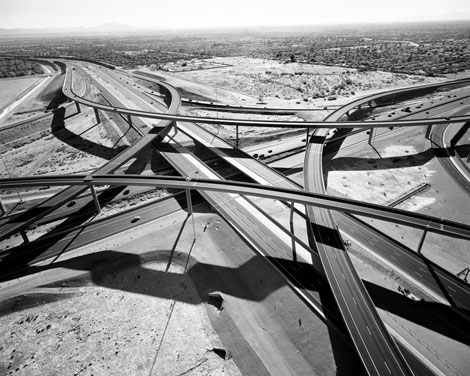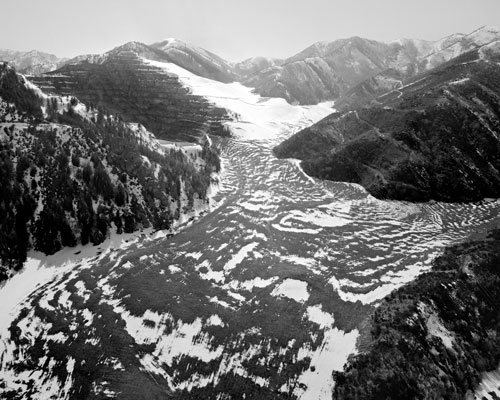Michael Light has been shooting photographs of the western U.S. landscape for over 20 years. They are generally taken from a small light airplane that he flies himself, and explore the majesty of these vast and variegated lands, creating dense patterns akin to abstract art. At the same time, many sites reveal details about our use of the land showing it to be anything but a beautiful or intangible design. While Light himself steers clear of moralizing about how and why the land is tilled, mined, tunneled, poisoned, drained of resources or riveted with abandoned artifacts, the viewer can infer Light’s extended considerations about what is going on out of sight in the immense hinterlands of the West. His current exhibition “Idaho, Two Sublimes,” places rather different takes on Idaho side by side as a way of bracketing the artist’s overarching photo project.
The “Sawtooth Mountains; Stanley, Idaho” series (2009) of large-scale black-and-white prints is aligned with a study of romantic beauty, a romanticism that is generated by the sheer scale depicted and the kinship to landscape painters such as Caspar David Friedrich or Albert Bierstadt. The closely cropped images have no horizon line, since they are viewed from above, and alternate between jagged, flattened modernist-like patterns and oddly displaced and weightless landmasses. The use of the stark black and white further skews a viewer’s ability to recognize the mountains. Light appears to employ this mental distance to suggest viewers look more closely. Beauty is central to his construction of meaning but throughout is his ability to cause skepticism and doubt.

Michael Light, Interchange of Highways 60 and 202 Looking West, Mesa, AZ, 2007. Courtesy of Craig Krull Gallery.
Works in his other series delve into human usage of the earth. The foregrounds center on outlying areas of our wilderness turned into places for dumping, storing and testing an incredibly messy and dangerous weapons system. Strangely iconic when seen from the sky, the circular and square buildings and connecting roadways that have been cut into the land almost turn into emblems or talismans, beautiful in their own right. Once abandoned, however, they look more like scar tissue on the earth than a symbolic beacon of ongoing societal or industrial progress. Light provides us with a tangible reminder that off in the distance and out of view, the military industrial complex is busy turning the wheels of its bellicose enterprise, churning up the earth in its path.
Michael Light’s double take hinges on our moving back and forth between the stirring majesty of the one set of images and the history of destruction the other recounts. The power of his images reside in the mixture of surface beauty and depth of truth he discovers. Implicitly sharing the company of photographers such as Richard Misrach, collectives such as CLUI, and activists such as EcoFlight, he moves us to examine and critically account for our world.


